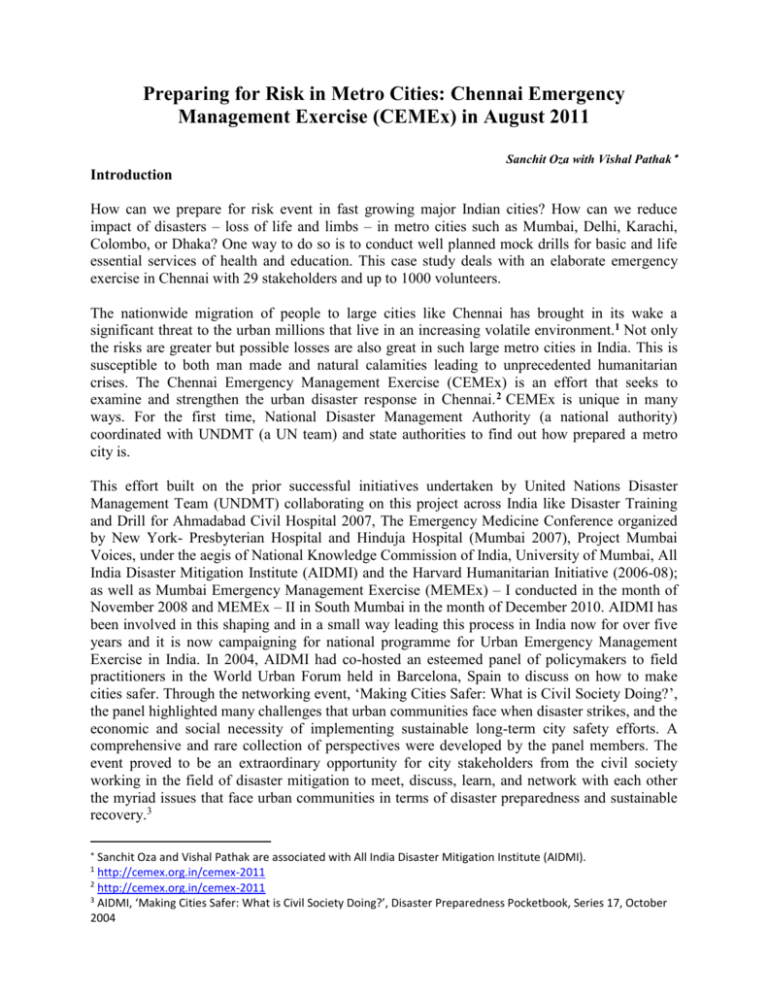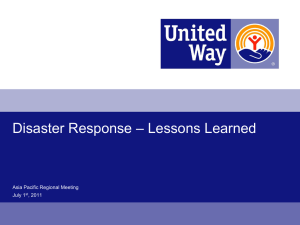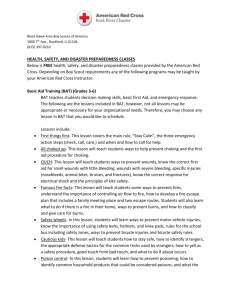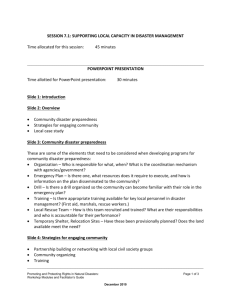Full report
advertisement

Preparing for Risk in Metro Cities: Chennai Emergency Management Exercise (CEMEx) in August 2011 Sanchit Oza with Vishal Pathak Introduction How can we prepare for risk event in fast growing major Indian cities? How can we reduce impact of disasters – loss of life and limbs – in metro cities such as Mumbai, Delhi, Karachi, Colombo, or Dhaka? One way to do so is to conduct well planned mock drills for basic and life essential services of health and education. This case study deals with an elaborate emergency exercise in Chennai with 29 stakeholders and up to 1000 volunteers. The nationwide migration of people to large cities like Chennai has brought in its wake a significant threat to the urban millions that live in an increasing volatile environment.1 Not only the risks are greater but possible losses are also great in such large metro cities in India. This is susceptible to both man made and natural calamities leading to unprecedented humanitarian crises. The Chennai Emergency Management Exercise (CEMEx) is an effort that seeks to examine and strengthen the urban disaster response in Chennai. 2 CEMEx is unique in many ways. For the first time, National Disaster Management Authority (a national authority) coordinated with UNDMT (a UN team) and state authorities to find out how prepared a metro city is. This effort built on the prior successful initiatives undertaken by United Nations Disaster Management Team (UNDMT) collaborating on this project across India like Disaster Training and Drill for Ahmadabad Civil Hospital 2007, The Emergency Medicine Conference organized by New York- Presbyterian Hospital and Hinduja Hospital (Mumbai 2007), Project Mumbai Voices, under the aegis of National Knowledge Commission of India, University of Mumbai, All India Disaster Mitigation Institute (AIDMI) and the Harvard Humanitarian Initiative (2006-08); as well as Mumbai Emergency Management Exercise (MEMEx) – I conducted in the month of November 2008 and MEMEx – II in South Mumbai in the month of December 2010. AIDMI has been involved in this shaping and in a small way leading this process in India now for over five years and it is now campaigning for national programme for Urban Emergency Management Exercise in India. In 2004, AIDMI had co-hosted an esteemed panel of policymakers to field practitioners in the World Urban Forum held in Barcelona, Spain to discuss on how to make cities safer. Through the networking event, ‘Making Cities Safer: What is Civil Society Doing?’, the panel highlighted many challenges that urban communities face when disaster strikes, and the economic and social necessity of implementing sustainable long-term city safety efforts. A comprehensive and rare collection of perspectives were developed by the panel members. The event proved to be an extraordinary opportunity for city stakeholders from the civil society working in the field of disaster mitigation to meet, discuss, learn, and network with each other the myriad issues that face urban communities in terms of disaster preparedness and sustainable recovery.3 Sanchit Oza and Vishal Pathak are associated with All India Disaster Mitigation Institute (AIDMI). http://cemex.org.in/cemex-2011 2 http://cemex.org.in/cemex-2011 3 AIDMI, ‘Making Cities Safer: What is Civil Society Doing?’, Disaster Preparedness Pocketbook, Series 17, October 2004 1 The emergency management exercises are especially important as vulnerability of large cities to disasters is increasing due to unplanned urbanisation resulting in environmental degradation (e.g. deforestation), over-exploitation of natural resources (e.g. water), ecological disturbances (e.g. pollution), and social destitution (e.g. increase in poverty). Increased population concentrations and poor construction further increase the vulnerability of built environment and the fragility of socio-economic systems. At the same time, economic growth and the resulting social changes have exposed them to various kinds of technological and fire hazards. Moreover, climate change has also increased the frequency and intensity of natural hazards.4 Climate related disasters such as flooding, flash floods, tropical cyclones, drought, wildfires and heat waves now affect more people worldwide. Climate change is accelerating and the melting of glaciers has severe consequences, among them glacial lake outbursts and flash floods. Sea level rise will put hundreds of cities, in low-elevation coastal zones, at risk of disaster, according to the Intergovernmental Panel on Climate Change. UN-HABITAT estimates that there are 3,351 cities located in low-elevation coastal zones around the world. Of the top 30 cities, 19 are in river deltas. The top ten, in terms of population exposed to coastal flood hazard, are Mumbai, Guangzhou, Shanghai, Miami, Ho Chi Minh City, Kolkata, Greater New York, Osaka-Kobe, Alexandria and New Orleans.5 In order to make disaster resilient cities, it is important to adopt an integrated approach that takes into account multiple hazards and vulnerabilities for comprehensive assessment, mitigation and preparedness and integrate disaster risk reduction into sustainable urban development goals. Cities and local governments need to get ready, reduce the risks and become resilient to disasters. To strengthen cities’ readiness against floods and other natural hazards, UN/ISDR has launched the ‘Making Cities Resilient: My City is Getting Ready’ campaign to raise awareness and urge mayors and local governments to invest more in disaster risk reduction. The campaign addresses issues of local governance and urban risk while drawing upon previous ISDR Campaigns on safer schools and hospitals, as well as on the sustainable urbanizations principles developed in the UN-Habitat World Urban Campaign 2009-2013.6, 7 Some of these lessons from Chennai are taken by AIDMI to shaping of National School Safety Programme of National Disaster Management Authority in its inception workshop on September 1 to 2, 2011. Initiative The Chennai Emergency Management Exercise (CEMEx), scheduled between August 04 – 08, 2011 was the result of multi- institutional public- private partnership that was designed to harness the strengths and capabilities of regional emergency responders, educational institutions, hospitals, humanitarian agencies and state agencies as they prepare to confront urban catastrophes. 8 It shed new light on urban humanitarian emergency settings and opened assessment of preparedness to many stakeholders in a collaborative and cooperative manner. 4 http://www.iihs.co.in/programmes/pwp/iudrr/ http://www.un.org/en/events/disasterreductionday/campaign-kit.pdf 6 http://www.unisdr.org/english/campaigns/campaign2010-2011/about/ 7 http://www.hydrology.nl/mainnews/1-latest-news/198-unisdr-warns-against-building-in-flood-prone-areas-.html 8 CEMEx Educational Track Report, AIDMI 5 This multi-disciplinary training and exercise fostered the development of skill sets focused on emergency management during mass casualty events, while providing an opportunity for local agencies to work together and practice a multi-disciplinary, coordinated response to a local disaster. The urgent process is hands on and realistic. It shows what are the initial considerations and true or useful they are; it helps in targeting areas and communities; and presentation of data. The train-the-trainer approach of the course and drill enabled local partners to eventually replicate the training and drill elsewhere in the region. Finally, the course and drill helped identify the strengths and weaknesses of the city's emergency management plans and help to better prepare the city for future events. This city-level exercise served to create a locally driven, multi-disciplinary, sustainable commitment to emergency management activities and became a tested-evaluated-validated model that can be easily reproduced in other cities and countries. After success of the Educational Track under the MEMEx I in 2008 and II in 2010, the UNDMT and other respective organisers again thrust their faith in the AIDMI to execute activities of Educational Track under CEMEx. This CEMEx work also fits into and adds value into ongoing review of city disaster management plans and district disaster management plans in India with National Disaster Management Authority and CordAid support. In addition, the exercise offers to examine a wider picture of capacity to respond in cities and towns in India in terms of policy framework, public structures, education, institutional capacities, training needs, and nationwide urban need for preparedness. This exercise also offers UN system ways to address risk in urban settings with coordination of national, state, and city level authorities in addition to communities. In a small way, this exercise also unites the partitioned citizens between those who are prepared and protected and those who are not. Goals and Objectives The goals and objectives of the CEMEx were as follows: To harness the strengths and capabilities of regional emergency responders, educational institutions, hospitals, humanitarian agencies and state agencies as they prepare to confront urban catastrophes. To examine and strengthen the urban disaster response in Chennai. To develop an education based approach to risk management. To increase local capacities for disaster preparedness and response by promoting awareness among schoolteachers, administrators, and other stakeholders. To enhance the knowledge and awareness of the participants on the topics of: 1. Public Health Assessment 2. Emergency Nursing Care 3. School and Higher Education Preparedness9 4. Hospital Emergency Management 5. Industrial and Chemical Disaster Preparedness 6. Comprehensive Trauma Life Support 7. IT and Hotel Disaster Preparedness 9 CEMEx Education Track Report, All India Disaster Mitigation Institute, August 2011 To build local capacities for multi-hazard disaster management in vulnerable schools and higher educational institutions of Chennai. to increase local capacities for disaster preparedness and response by promoting awareness among schoolteachers, administrators, and other stakeholders and providing understanding of disasters to nontechnical group - a common man.10 Impacts and Results CEMEx was held in Chennai from August 4 – 8, 2011. The program focused on building capacities of local bodies while managing a disaster in the heavily populated city of Chennai. The program was conducted to enhance the disaster preparedness of the stakeholders in case a contingency were to occur. It was a rigorous 5 day long event in which various trainings were held followed by a massive major incident – simulation drill. The trainings made impact in the following manner: Public Health Assessment course taught senior level public health practitioners, community medicine PG’s and disaster management personnel the skills needed to evaluate disaster response systems. It overviewed various components of disaster response and practical tools to evaluate the response. The findings of the High Level Expert Group on Universal Health Coverage set up by the Planning Commission may not have directly dealt with emergency health needs after disaster in an urban setting. This exercise offered some sessions for this Expert Group. Communication workshop focused on what information each agency would like from the other during disasters. Information on fast growing urban infrastructure was top on the list. Similarly, information on urban governance was also high on the list of emergency information needs in Chennai. Questions about long term strategic urban planning also came up in terms of information need. Information on urban poor was in short supply in each sector. A two day course on Disaster Preparedness for School Safety; and Disaster Risk Reduction in Higher Educational Institutions was conducted by AIDMI. It targeted the school administrators and focused on the need to impart disaster preparedness education in schools and colleges. It proved instrumental in spreading awareness about school safety and making schools safer.11 With the Right to Education (RTE) Act, 2009 having come into effect from April 2010, it is now a fundamental right of all children to demand eight years of quality elementary education. And it goes without saying that this elementary education has to be safe from the risk of natural disasters in cities and towns. AIDMI track provided excellent insights into making RTE in urban areas safer. Industrial and Chemical Disaster Preparedness targeted at administers of various industries and suburban Chennai regarding disaster preparedness and audit for industries. Emergency medical services training boosted the confidence, skills and knowledge of first responders as they need to provide the highest level of immediate care in disaster setting. The experience showed the need for more thinking on disasters and health in moving towards more comprehensive healthcare in cities. The health infrastructure in 10 11 CEMEx Education Track Report, All India Disaster Mitigation Institute, August 2011 CEMEx Education Track Report, All India Disaster Mitigation Institute, August 2011 cities is better than in rural areas but it is not planned to survive or respond to sudden and wide scale emerging health needs. Similarly, it became clear that the human resource for emergency health response in a city is yet small, not trained, and inexperienced to sudden and widespread demands. Far more thinking is needed on publicly financed urban health in India. Nursing staff were trained in an exclusive track for two days in handling various aspects of prioritized patients. Comprehensive Trauma Life Support aimed at teaching the participating doctors how to assess resuscitate and deliver initial care in a logarithmic manner to patients with major trauma. Hospital Emergency Management course was organized to improve the ability of hospital management and intra hospital care during events of mass casualty. In general, universal healthcare has gaps in terms of emergency medicine. The Good Practice The key aim of CEMEx 2011 was to foster the development of skill sets focused on emergency management. The initiative was exceedingly successful in introducing new methods of training due to the experience and knowledge of the reputed faculties – both national and international. The trainings and mock drills enhanced and built capacities of local bodies in times of disasters. AIDMI has conducted trainings on ‘Disaster Preparedness for School Safety’; and ‘Disaster Risk Reduction in Higher Educational Institutions’. The trainings have relevance to Sarva Shiksha Abhiyan and Rashtriya Madhyamik Shiksha Abhiyan in terms of both, quality of education and the education infrastructure in urban areas. The trainings were attended by 83 participants from total 66 schools/higher education institutions. The participants included educators, administrators and safety officers from municipal, and government aided schools as well as higher educational institutions, all of whom will in turn serve as trainers to impart the school safety trainings to other stakeholders in their respective regions. Trainers and participants engaged in a number of activities including multimedia presentations, group exercises, case study analysis, participant presentations, video case study, open discussions, fire demonstration and usage, and learning games. All activities were designed to build education institutions’ capacities for disaster risk reduction by promoting scientific understanding of disasters; stressing the need for preparedness of schools and higher educational institutions; conveying the needs and roles of stakeholders.12 Several broad issues were raised such as integration of pre-school education, funding early childhood care and education, and safety of children receiving education in low income areas. Chennai is a large city and the authorities always have to be on their toes to reply to disasters in case they are to occur. After tsunami, the city has invested a lot in its preparedness and risk reduction. Thus, CEMEx highlighted the importance of disaster preparedness in different sectors of the city. The initiative provided an opportunity to all the stakeholders to work in coordination. Thus CEMEx proved very essential and crucial in bringing all the government as well as private, humanitarian units of Mumbai city together to plan and improve the current state of disaster management of the city. 12 CEMEx Education Track Report, All India Disaster Mitigation Institute, August 2011 AIDMI found that with rising population of Chennai, CEMEx lessons have far more relevance in coming years, and fast growing Chennai offers a challenge and opportunity, both, for disaster preparedness. Provision of urban preparedness infrastructure – health, education, water, and more – seems a rapid and full review in Chennai by multiple inside and third party stakeholders. The areas for focus in such a review way include governance, capacities, financing, city planning, and city-state roles in Chennai. Potential for Replication CEMEx 2011 was based on a similar prior initiative of Mumbai Emergency Management Exercises (MEMEx) in 2008 and 2010, both held in Mumbai. It was an outcome of multi institutional public- private partnership designed to harness the strengths and capabilities of regional emergency responders, educational institutions, hospitals, humanitarian agencies as they try to confront urban catastrophes. Conducting similar initiatives in the urban cities of India is the need of the hour as they are becoming vulnerable by the day due to various issues like heavy migration, unplanned city expansion etc. The program is still pending in the other two major urban cities of Delhi and Kolkata. EMEx in these cities would prove rather encouraging and fruitful for the city authorities. The success of CEMEx needs to be transformed into EMEx in other vulnerable urban locations in Tamil Nadu. We know more about methods of EMEX, tools, schedules, manuals and more by now. The material has wide and diverse range and scope for utilization. The above mentioned knowledge products on EMEX must be systematically used. How to use this material for education of Emergency Managers in Health, Education and other fields? May be an EMEX Course? The courses can be diploma, certificate and even degree course within Emergency Medicine or Urban Planning or Education Sector. More thoughts and efforts need to be put into this.13. It is recommended that Micro CEMEx programs should be organized for schools and higher educational institutions 14 . The stakeholders should be well aware of the increasing dangers in urban cities and should carry out emergency preparedness training in as many cities as possible. Such developmental approach to humanitarian crisis is especially crucial, and possible, in spreading urban resilience in India.15 Regional Relevance So what is regional relevance of CEMEx to cities of Colombo, Dhaka, Karachi, and Kathmandu in South Asia? As cities lead economic growth in South Asia, their safety from and preparedness for a major disaster is even more important. By preparing cities upward, move of strong economic fundamentals and improving economic performance over past five years can be protected. Protecting cities is necessary for generating income and employment as well as generating resources to invest more in reducing risk in cities and rural areas to protect citizens. 13 14 CEMEx Concluding Remarks: Towards National Framework for EMEx in Cities of India by Mihir Bhatt, AIDMI CEMEx Education Track Report, All India Disaster Mitigation Institute, August 2011 15 CEMEx Concluding Remarks: Towards National Framework for EMEx in Cities of India by Mihir Bhatt, AIDMI







